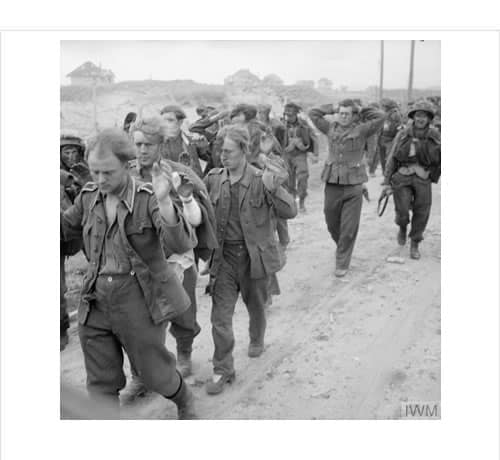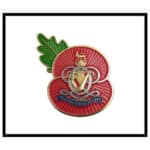Ex Tpr P A Wilcox, ‘B’ Sqn, 8th KRI Hussars.
We now found ourselves back in the close country south of Caumont and advancing in the direction of Aunay-sur-Odon and a high feature called Mont Pincon.
And so began the mixture as before: stubborn resistance by the Germans and advances measured in yards.
Since the initial landings on the beaches in June, when a few miles advance was made, it had now developed into a war of attrition, with severe losses on both sides, and the infantry regiments were bearing the brunt of it.
I remember about this time the 1/6th Battalions of the ‘Queen’s Regt’, with whom we had worked closely, had been so badly cut up that they were barely able to muster one company of around 100 men, out of a battalion strength of 300 plus.
There was a lot of good natured ribald bantering between us and the infantry. In some situations they would be screaming out for tank support, when we weren’t there, and when we were, the usual comment was ‘Go away, you noisy Tankies, you’ll give our positions away!’ And if we moved up under the cover of darkness it always brought instant reaction from the Germans in the form of shelling or mortaring.
Having advanced through the ruins of Aunay-sur-Odon, which was just a pile of rubble, we were ordered back for a rest, which brought no complaints from anybody. It was most welcome to be able to have a hot water shave and change our socks, etc.
If my memory serves me correctly, it is while we were here that we were taken into Bayeux for a shower and also a film show. Such undreamed of luxuries! And just to show what a small world it is, whilst walking along a street to the cinema, I bumped into a chap out of the 22nd Dragoons who joined the army the same day as me, and also another who was a relative by marriage and was in the RA.
Our rest was short-lived as we had been ordered to move back to the Caen area. Apparently, at about this time the Americans had broken out of the Cherbourg peninsular and were turning the left flank of the German army. The pressure exerted at Caen was beginning to pay off. Also, the Canadians had broken out of the area south of the town and were moving towards Falaise.
Our objective, apparently, was to exploit the break and move east towards the River Seine.
Around the middle of August we began to move east, in the direction of St. Pierre-sur-Dives, over the River Orne at Muysur- Orne, which was just the usual pile of rubble, and we reached St. Pierre late in the day.
A vivid memory of this time, and it was probably made worse by the onset of hot weather, is the smell of decaying bodies, be they human or animal. Once you have experienced it you can never forget it. Even as I write, I can still recall it.
I remember one occasion when we were moving along some of these minor roads, having to halt for some reason and, over the hedge, there would be perhaps one or more decaying bodies of horses or cows, or even humans. Whilst we were halted it would be a most distressing time and by the time we moved on, many of the chaps had got rid of any food they may have had that day.
As I said before, we passed through St. Pierre-sur-Dives late in the day, and were surprised to see that it was almost unchanged. It had been cleared by the Highland Division. About a mile beyond the town we were directed into a large field at the side of the road, and then proceeded to position ourselves around the four sides, taking advantage of the hedgerows for as much camouflage as we could make.
As the German Air Force was still making it’s presence felt, mostly after dark, certain precautions still had to be taken. Just before dusk, a light AA unit moved into the field and set up their Bofors gun in the centre. We watched them with mixed feelings.
Following their usual practice, the Luftwaffe sent over a couple of reconnaissance planes just before dusk, around 9 pm, and we wondered whose turn it was going to be that night. At around midnight part of the answer was revealed to us. In the distance we could hear the familiar throb, throb of German bombers. A few moments later, the whole field was lit up as bright as day from the chandelier flares that the Germans were dropping.
A few uneasy moments later, the bombs started to fall all over the area. As there were no slit trenches available, we just had to sit tight in our vehicles and hope for the best. The Troop Corporal, to whom I had been speaking, jumped into my scout car with me and I closed the roof down.
We both sat there listening to the racket going on all around, now and then feeling the ground tremble as one dropped uncomfortably close. After about an hour or so, things started to quieten down and, eventually, I lifted the roof cover to have a look around.
On our side of the field we had escaped damage, but the far side hadn’t been so lucky. An ammunition truck had been hit and also the Squadron water carriers, whose two-man crew had been killed. A few hours earlier, we had all been chatting and joking together and now all that was left was a couple of blackened, heat-seared torsos.
Before moving on, I must express a word of praise for the three-man crew of the AA gun that had been positioned in the centre of the field. They never stopped firing throughout. A literal example of the expression ‘sticking to your guns’.
Moving out of St. Pierre-sur-Dives, we advanced in the general direction of Livarot, about 10 miles distant, and although the general feeling was that the German Army was retreating out of France, as far as those in our sector were concerned, they apparently hadn’t got the message. They insisted at every opportunity on trying to obstruct us. Most unsporting of them. A few mines laid here and there, the odd anti tank gun, or even, and most unpleasant, the occasional sniper left in a church tower or some other high feature in the countryside.
Towards the end of August we had reached the town of Livarot, and after a couple of days’ fighting, the town was cleared.
Incidentally, I believe it was the first place we had taken that wasn’t a pile of ruins. It made a nice change to see houses all in one piece, and people coming out of them to welcome us. The natives were becoming decidedly more friendly the further eastwards we went. And so on to Lisieux, which was taken after a couple of days of ‘nastiness’.
By the last days of August, it was fairly apparent to all that, as far as France was concerned, the German Army was on the way out, but it was still a long way from being beaten.



